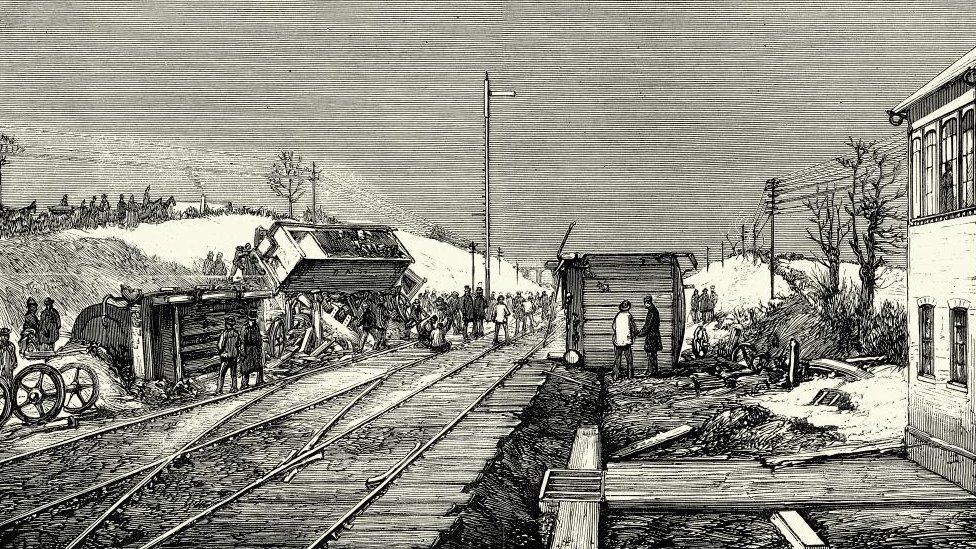Victims of 19th Century Cambridgeshire rail crash remembered
- Published

A drawing shows the aftermath of the collision in a blizzard near Abbots Ripton
Thirteen people who died in a crash involving three trains are being remembered 148 years later.
The grave of one of the victims of the disaster at Abbots Ripton near Huntingdon in Cambridgeshire has been restored.
An interpretation board telling the story of the crash has been installed.
A passenger service collided with an express train in a blizzard, and another train then ran into the wreckage.
The accident involved the Flying Scotsman, which was the nickname at the time for the Special Scottish Express between London and Edinburgh.
The iconic locomotive bearing the same name was built in 1923 and was used for the London to Edinburgh service.
The Special Scottish Express, known as the Flying Scotsman, eventually gave its name to a world-famous locomotive
On 21 January 1876, the Special Scottish Express left Peterborough on time at 18:18 GMT.
A coal train was ahead of the Express on the same line, not as far away as it should have been as it had been delayed.
The signalman at Holme was told to guide the freight train into a siding, but the poor visibility caused the driver to carry on straight past the siding.
The inquiry found later, external that the weight of snow on the signals had left them showing as "clear" even though they had been set to "danger".
The East Coast Main Line still runs near Abbots Ripton, although the railway station there closed in 1958
At Abbots Ripton, the coal train was directed into a siding by a signalman with a hand lamp.
As the locomotive was shunting into the siding, it was hit by the Special Scottish Express running at full speed.
With the Scottish Express on its side across both lines, another express train hurtled into the wreckage.
As well as 13 deaths, the accident caused 53 injuries among the passengers and six among the crew.
The incident led to changes to the way signals worked, and, eventually, to better braking systems on locomotives.
The grave of Dion William Boucicault, who died in the crash, was in need of some tender loving care
One of the 13 victims was Dion William Boucicault, the son of a well-known Irish actor.
His grave in Huntingdon's Priory Road Cemetery has recently been restored by Charles Saunders, who lives locally, with help from a construction company.
He has worked on the railings, urn and base at his own cost.
The grave of Dion William Boucicault has been restored by Charles Saunders in his spare time
An interpretation board has been added at the cemetery to tell the story of the disaster and those who lost their lives.
An interpretation board has been added at the cemetery to tell the story of the accident and its victims
A ceremony is taking place on 22 January to unveil the board, and there are plans for more events on the 150th anniversary of the accident in 2026.
Follow East of England news on Facebook, external, Instagram, external and X, external. Got a story? Email eastofenglandnews@bbc.co.uk , externalor WhatsApp 0800 169 1830
Related Topics
- Published30 September 2023
- Published29 March 2023
- Published17 November 2018